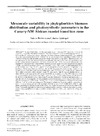Identificador persistente para citar o vincular este elemento:
https://accedacris.ulpgc.es/jspui/handle/10553/635
| Título: | Mesocale variability in phytoplakton biomass distribution and photosynthetic parameters in the Canary-NW African coestal transition zone | Autores/as: | Basterretxea Oyarzabal, Gotzon Aristegui, J. |
Clasificación UNESCO: | 251001 Oceanografía biológica | Palabras clave: | Fitoplancton marino Canarias Phytoplankton Chlorophyll Primary production, et al. |
Fecha de publicación: | 2000 | Publicación seriada: | Marine Ecology - Progress Series | Resumen: | Pigment distribution and photosynthesis versus irradiance (P-E) responses in the mixed layer (ML) and in the chlorophyll maximum (CM) were examined in the coastal transition zone (CTZ) between the NW African coastal upwelling and the Canary Islands during August 1993. The sampling included 2 island-generated eddies in the lee of the archipelago and an upwelling filament from the African continental shelf, entrained around a cyclonic eddy about 100 km width. Chlorophyll a and P E parameters (α, Pm) showed regional differences reflecting changes in the water column structure and phytoplankton species composition. The deep CM shoaled from ~100 to ~10 m as the African shelf was approached, and there was a clear offshore-onshore transition in the vertically integrated chlorophyll distribution and P-E responses related to the upwelling front. CM oceanic samples presented high α (0.020 to 0.042 mg C mg-1 chl h-1 [µmol m-2 s-1]-1) and photoinhibition, indicating adaptation to low irradiance. Differences between CM and ML in P-E responses decreased in the vicinity of the upwelling until they eventually became indistinguishable in a well-mixed station on the continental shelf. Island-generated eddies affected mainly the productivity and chlorophyll distributions at the deep CM. Nutrient input in the eddy center resulted in an increase of α in the CM to the level of the upwelling samples (~0.053 mg C mg-1 chl h-1 [µmol m-2 s-1]-1). On the basis of the mesoscale variability in the physical structure of the water column and the vertical distribution of chlorophyll, the CTZ was divided into 4 subregions with characteristic photosynthetic parameters. Average integrated production in these areas varied from ~100 mg C m-2 d-1 in the most oligotrophic subregion to more than 5000 mg C m-2 d-1 in the upwelling zone. The range of variation in the photosynthetic parameters in this CTZ was of the same magnitude as ranges observed in basin-scale studies of the Atlantic. Integrated production estimates are also in the lower and higher extremes of the observed values in the ocean. Our results highlight the importance of addressing the variability of the photosynthetic parameters in coastal upwelling-open ocean transition zones in order to model primary production at regional scales. | URI: | https://accedacris.ulpgc.es/handle/10553/635 | ISSN: | 0171-8630 | DOI: | 10.3354/meps197027 | Fuente: | Marine Ecology Progress Series [ISSN 0171-8630], v. 197, p. 27-40 |
| Colección: | Artículos |
Citas SCOPUSTM
59
actualizado el 08-jun-2025
Citas de WEB OF SCIENCETM
Citations
57
actualizado el 08-jun-2025
Visitas
57
actualizado el 10-ene-2026
Descargas
67
actualizado el 10-ene-2026
Google ScholarTM
Verifica
Altmetric
Comparte
Exporta metadatos
Los elementos en ULPGC accedaCRIS están protegidos por derechos de autor con todos los derechos reservados, a menos que se indique lo contrario.
